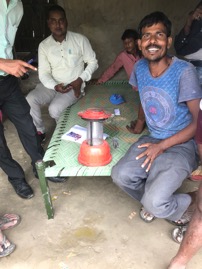Blog

Kerosene use is ubiquitous in India, especially among rural households. According to the latest Census statistics, about 31% of Indian households use kerosene for lighting, and this increases to 43% among the rural population. According to the World Health Organization, kerosene use can trigger many health issues and reducing the use of kerosene lamps is critical for lowering indoor air pollution levels. Given the widespread use of kerosene in India, we know very little about the attitudes and the behavior of such users.
Do they support the subsidies they receive from the government for the kerosene? Would they trade the subsidies if it was offered to them on a solar lantern? And most importantly, would their preference for kerosene actually reduce if they used a solar lantern? This is a critical issue since many existing surveys typically just record a household’s reported response. This could greatly differ from their behavioral response. Hence examining whether a household’s preference for kerosene decreases because of kerosene use should depend on whether we can observe a change in their actual behavior.
In August 2018, I was involved in two projects aimed to answer these questions. In the first project, we implemented a survey across the state of Uttar Pradesh. The survey included detailed questions on kerosene use, support for kerosene subsidies and perception of solar technology. The survey covered 1,000 households sampled across both small and large villages, making it one of the most comprehensive surveys ever conducted on kerosene use in the country.

Kerosene users can typically choose to subscribe to either the main electricity grid or obtain light from a solar home system. The choice between these two options is not obvious – it could depend on many factors. For example, it could depend on the number of hours of electricity, the one-time connection fee, the monthly fee or the number of appliances. To determine the causal impact of these factors, we embedded a conjoint experiment within the survey.
Respondents are provided with two profiles: grid and solar lantern. In each profile, we provide them information on the number of hours of electricity, the one-time connection fee, the monthly fee or the number of appliances. These are presented ‘side-by-side’ allowing respondents to compare between them. We then record their preference for either grid or solar lantern. This approach is significant since it allows us to isolate the precise impact of each factor, and would not have been possible if we had just asked respondents to compare these different factors.

In the second project, we measured the actual behavior of the kerosene users. We implemented a baseline behavioral game that elicited a truthful response from users on exactly how much they would pay for one liter of kerosene. This was not a hypothetical exercise since we actually bought kerosene from a local shop to offer it to the users. This added a sense of reality into our understanding of how to wean users away from kerosene.
What we intend to do next is to replay this behavioral game after the households have had some experience with solar lanterns. We will distribute solar lanterns to a random subset of households and then replay the game for a second time after 3/6 months. In this way, we can check whether household’s actual behavior changed because of the use of the solar technology. This is critical because such a behavioral change is a more effective indicator than a simple survey response
Stay tuned for results…


***
S.P. Harish is the Assistant Professor of Government at the College of William & Mary. He is the ISEP Associate Director of the Behavioral Laboratory.
